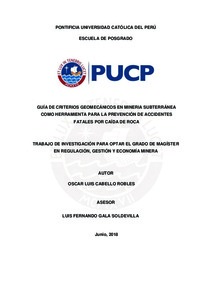| dc.contributor.advisor | Gala Soldevilla, Luis Fernando | |
| dc.contributor.author | Cabello Robles, Oscar Luis | es_ES |
| dc.date.accessioned | 2018-11-24T17:08:58Z | es_ES |
| dc.date.available | 2018-11-24T17:08:58Z | es_ES |
| dc.date.created | 2018 | es_ES |
| dc.date.issued | 2018-11-24 | es_ES |
| dc.identifier.uri | http://hdl.handle.net/20.500.12404/13029 | |
| dc.description.abstract | Si bien es cierto que el número de accidentes fatales en la minería peruana se ha ido reduciendo en el periodo 2000-2016, aún se han mantenido los accidentes por caída de roca como causa número 1 de las fatalidades. El objetivo del presente trabajo es investigar las causas de los accidentes de caída de roca, que incluyen múltiples factores entre ellos: La Calidad del Macizo rocoso, El Método de minado, Daños causados por voladura, Estándares de la empresa, Sistemas de Gestión, Capacitación del personal y Normativa vigente. Es necesario notar que es un problema que tiene múltiples aristas, hay aspectos no están siendo considerados en la normativa de seguridad minera, sin embargo, la regulación no siempre es la
respuesta. Por ende, sin ánimo de caer en una sobre-regulación, se identificó que una guía de criterios geomecánicos es una herramienta que puede ayudar a reducir el número de accidentes fatales por caída de roca en minería subterránea, esta guía servirá como referente técnico para desarrollar un minado subterráneo seguro. Para los resultados del presente trabajo de investigación ha sido necesario emplear el método histórico en el periodo (2000-2016) y el método de comparación de casos, evaluando los casos de países mineros como Chile y Australia, siendo notable este último, en el cual los australianos han logrado reducir a prácticamente a cero los accidentes fatales por caída de roca. Como resultado de la presente investigación se describe el contenido mínimo que debería incluir una guía geomecánica, el enfoque y contenido principal de ésta. Se concluye que el reducir los accidentes por caída de rocas, es una labor interdisciplinaria. Una herramienta técnica para lograr este objetivo (sin caer en la sobre-regulación) es una guía de criterios geomecánicos para minería subterránea | es_ES |
| dc.description.abstract | Although it is true that the number of fatal accidents in Peruvian mining has been reduced in the period 2000-2016, accidents due to rock fall have remained as the number one cause of fatalities. The objective of this work is to investigate the causes of rock fall accidents, which include multiple factors including: rock Mass, mining Method, damage caused by blasting, company standards, management systems, staff Training and current regulations. It is necessary to notice that it is a problem that has multiple edges, there are aspects that are not being considered in the mining safety regulations, however, regulation is not always the answer. Therefore, without the intention of falling into an over-regulation, it was identified that Geomechanical Guide is a tool that can help reduce the number of fatal accidents due to rock fall
in underground mining, this guide will serve as a technical reference to develop a safe
undermining. For the results of this research work it has been necessary to use the historical method in the period (2000-2016) and the case comparison method, evaluating the cases of mining countries such as Chile and Australia, the latter being notable, in which the Australians have managed to reduce fatal accidents caused by falling rock to practically zero. As a result of this research we describe the minimum content that should include a geomechanical guide, its focus and content. It is concluded that reducing accidents due to rock fall is an interdisciplinary task. A technical tool to achieve this objective (without falling into over-regulation) is a Geomechanical Guide for underground mining | es_ES |
| dc.description.uri | Trabajo de investigación | es_ES |
| dc.language.iso | spa | es_ES |
| dc.publisher | Pontificia Universidad Católica del Perú | es_ES |
| dc.rights | info:eu-repo/semantics/openAccess | es_ES |
| dc.rights.uri | http://creativecommons.org/licenses/by-nc-nd/2.5/pe/ | * |
| dc.subject | Seguridad industrial--Perú | es_ES |
| dc.subject | Accidentes--Prevención--Perú | es_ES |
| dc.subject | Industria minera--Perú | es_ES |
| dc.subject | Explotación subterránea (Minería)--Perú | es_ES |
| dc.title | Guía de criterios geomecánicos en minería subterránea como herramienta para la prevención de accidentes fatales por caída de roca | es_ES |
| dc.type | info:eu-repo/semantics/masterThesis | es_ES |
| thesis.degree.name | Magíster en Regulación, Gestión y Economía Minera. | es_ES |
| thesis.degree.level | Maestría | es_ES |
| thesis.degree.grantor | Pontificia Universidad Católica del Perú. Escuela de Posgrado | es_ES |
| thesis.degree.discipline | Regulación, Gestión y Economía Minera | es_ES |
| renati.advisor.dni | 09997663 | |
| renati.advisor.orcid | https://orcid.org/0000-0001-6147-5630 | es_ES |
| renati.discipline | 724257 | es_ES |
| renati.level | https://purl.org/pe-repo/renati/level#maestro | es_ES |
| renati.type | http://purl.org/pe-repo/renati/type#trabajoDeInvestigacion | es_ES |
| dc.publisher.country | PE | es_ES |
| dc.subject.ocde | https://purl.org/pe-repo/ocde/ford#5.02.01 | es_ES |






